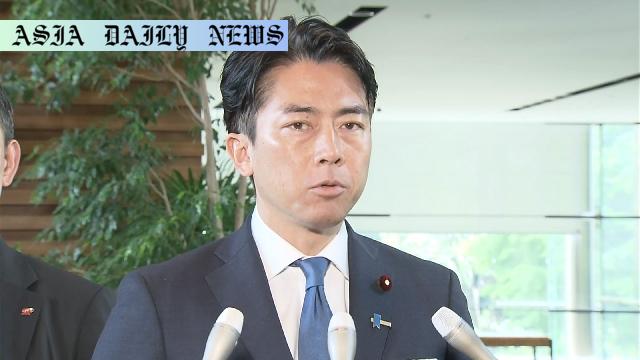Koizumi Shinjiro appointed as Japan’s agriculture minister to restore public confidence and stabilize rice prices.
- Appointment of Koizumi Shinjiro as Japan’s new agriculture minister.
- Aims to stabilize rice prices and boost public confidence.
- Koizumi’s extensive political experience and Cabinet roles were key factors.
- Resignation of Taku Eto paved the way for this transition.

Koizumi Shinjiro’s Appointment Marks a Strategic Shift
Japan’s Prime Minister Ishiba Shigeru has taken a critical step towards reinvigorating the administration’s agricultural policies by appointing Koizumi Shinjiro as the new Minister of Agriculture, Forestry, and Fisheries. This decision signals an effort to restore public trust and address agricultural challenges such as rice price stabilization in the country. This high-profile nomination comes on the heels of the resignation of Eto Taku, who stepped down on Wednesday morning.
Koizumi Shinjiro, 44, is no stranger to politics. Hailing from a prominent political lineage, he first entered the political arena in 2009, succeeding his father, former Prime Minister Koizumi Junichiro. Representing the Kanagawa District, Shinjiro quickly made his mark in Japanese politics, earning a reputation for his innovative approaches and strategic policymaking. This appointment as Agriculture Minister reflects the government’s choice to rely on seasoned politicians with proven track records in previous Cabinet roles.
Strong Foundations: Koizumi’s Political and Cabinet Experience
Koizumi is well-versed in governmental operations, having served as the environment minister in the administrations of both Shinzo Abe and Yoshihide Suga. His tenure at the Ministry of the Environment was marked by forward-thinking policies aimed at promoting sustainability, making him an ideal choice for a sector as vital as agriculture. The Ministry of Agriculture’s directive to stabilize rice prices and bring reforms to bolster self-sufficiency aligns closely with Koizumi’s policy expertise and strategic acumen.
His ambitious bids in the Liberal Democratic Party (LDP) leadership election also demonstrate his growing influence within the party. Despite finishing third in the initial round of voting, Koizumi emerged as a figure capable of securing support from numerous Diet members. His influence has been instrumental in rallying support around the LDP’s reform and stabilization measures. In taking over a post previously marked by difficulty and resignation, he will likely serve as a stabilizing presence within the Cabinet.
Challenges and Opportunities for Japan’s Agriculture
The appointment comes at a time when Japan faces unique agricultural challenges. Factors such as fluctuating rice prices, aging agricultural labor forces, and increasing reliance on imported goods paint a complex picture requiring capable leadership. Koizumi, with his advanced knowledge of agricultural policies and focus on economic stabilization, will be tasked with navigating these multifaceted challenges. The prime minister’s explicit intent, with this appointment, is to rebuild public confidence and demonstrate commitment to long-term solutions.
Furthermore, Koizumi’s appeal among Japan’s youth and modern-minded populace may also bring a revitalized perspective to the role. Communication with stakeholders, including farmers, agri-tech startups, export markets, and policymakers, will play a critical role in ensuring the viability of reforms. Introducing innovations in farming technology, subsidies, and sustainable farming techniques could mark significant achievements early in his tenure.
Conclusion
Koizumi Shinjiro’s appointment as agriculture minister underscores the Japanese government’s resolve to address pressing agricultural issues with seasoned leadership. By leveraging Koizumi’s rich experience and innovative mindset, the administration looks set to mitigate ongoing challenges while charting a bold new vision for Japan’s rice and broader agricultural sectors.



Commentary
Koizumi Shinjiro: A Timely Appointment for Japan’s Agricultural Sector
The appointment of Koizumi Shinjiro as Japan’s Minister of Agriculture, Forestry, and Fisheries comes at a crucial juncture for the nation. This decision reflects Prime Minister Ishiba Shigeru’s resolve to re-energize the government and address public concerns over economic and agricultural challenges within Japan. For a country that places immense cultural and economic value on its agricultural sector, Koizumi’s leadership may just be the pivotal change needed.
A Leader with Proven Credentials
Koizumi’s meteoric rise as a political leader is backed by his hands-on experience in diverse Cabinet roles. Whether as environment minister or as a prominent LDP figure, he has demonstrated pragmatism backed by a nuanced understanding of policy reforms. His reputation for innovative solutions will likely be essential in addressing systemic inefficiencies in the agriculture sector. The confidence placed in Koizumi by his peers and constituents alike is as much a testament to his capability as it is a mandate for action.
The Road Ahead: Expectations and Challenges
With a clear expectation to stabilize rice prices and address agricultural imports, Koizumi is inheriting a challenging portfolio. Japan’s rural communities are a crucial element of its socio-economic fabric, and their welfare directly impacts national prosperity. Successfully implementing sustainable farming technologies, increasing local produce competitive strength, and maintaining low costs for consumers are just some of the tasks he must manage with precision.
Ultimately, Koizumi Shinjiro’s success in this role has the potential to cement his standing not just within the LDP but as a national leader capable of driving transformative policies. This is an exciting chapter for Japan’s governance, with its agricultural agenda placed squarely under the spotlight.